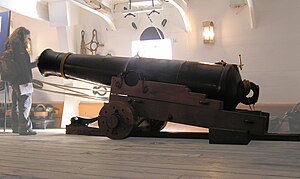| 68-pounder smoothbore cannon | |
|---|---|
 Replica 68-pounder aboard HMS Warrior. | |
| Type | Naval gun Coast Defence gun |
| Place of origin | United Kingdom |
| Service history | |
| In service | 1846–1921 |
| Used by | United Kingdom |
| Wars | Crimean War |
| Production history | |
| Designer | William Dundas |
| Manufacturer | Low Moor Ironworks |
| Unit cost | £225 [1] |
| Produced | 1841–1861 |
| No. built | In excess of 2,000 |
| Specifications | |
| Mass | 88, 95 or 112 cwt |
| Barrel length | 88 cwt: 9 feet 6 inches (2,896 mm) 95 cwt: 10 feet (3,048 mm) 112 cwt: 10 feet 10 inches (3,302 mm)[2][3] |
| Crew | 9 – 18 |
| Shell | Solid Shot Explosive Shell |
| Shell weight | 68 pounds (30.84 kg) |
| Calibre | 8.12 inches (20.62 cm) |
| Elevation | 0 – 15 degrees |
| Muzzle velocity | 1,579 feet per second (481 m/s) |
| Effective firing range | Approximately 3,000 yards (2,700 m) |
| Maximum firing range | 3,620 yards (3,310 m) |
The 68-pounder cannon was an artillery piece designed and used by the British Armed Forces in the mid-19th century. The cannon was a smoothbore muzzle-loading gun manufactured in several weights firing projectiles of 68 lb (31 kg). Colonel William Dundas designed the 112 cwt version in 1841[2] which was cast the following year. The most common variant, weighing 95 long cwt (4,800 kg), dates from 1846.[2] It entered service with the Royal Artillery and the Royal Navy and saw active service with both arms during the Crimean War. Over 2,000 were made and it gained a reputation as the finest smoothbore cannon ever made.
The gun was produced at a time when new rifled and breech loading guns were beginning to make their mark on artillery. At first the 68-pounder's reliability and power meant that it was retained even on new warships such as HMS Warrior, but eventually new rifled muzzle loaders made all smoothbore muzzle-loading guns obsolete. However, the large surplus stocks of 68-pounders were given new life when converted to take rifled projectiles; the cannon remained in service and was not declared obsolete until 1921.
